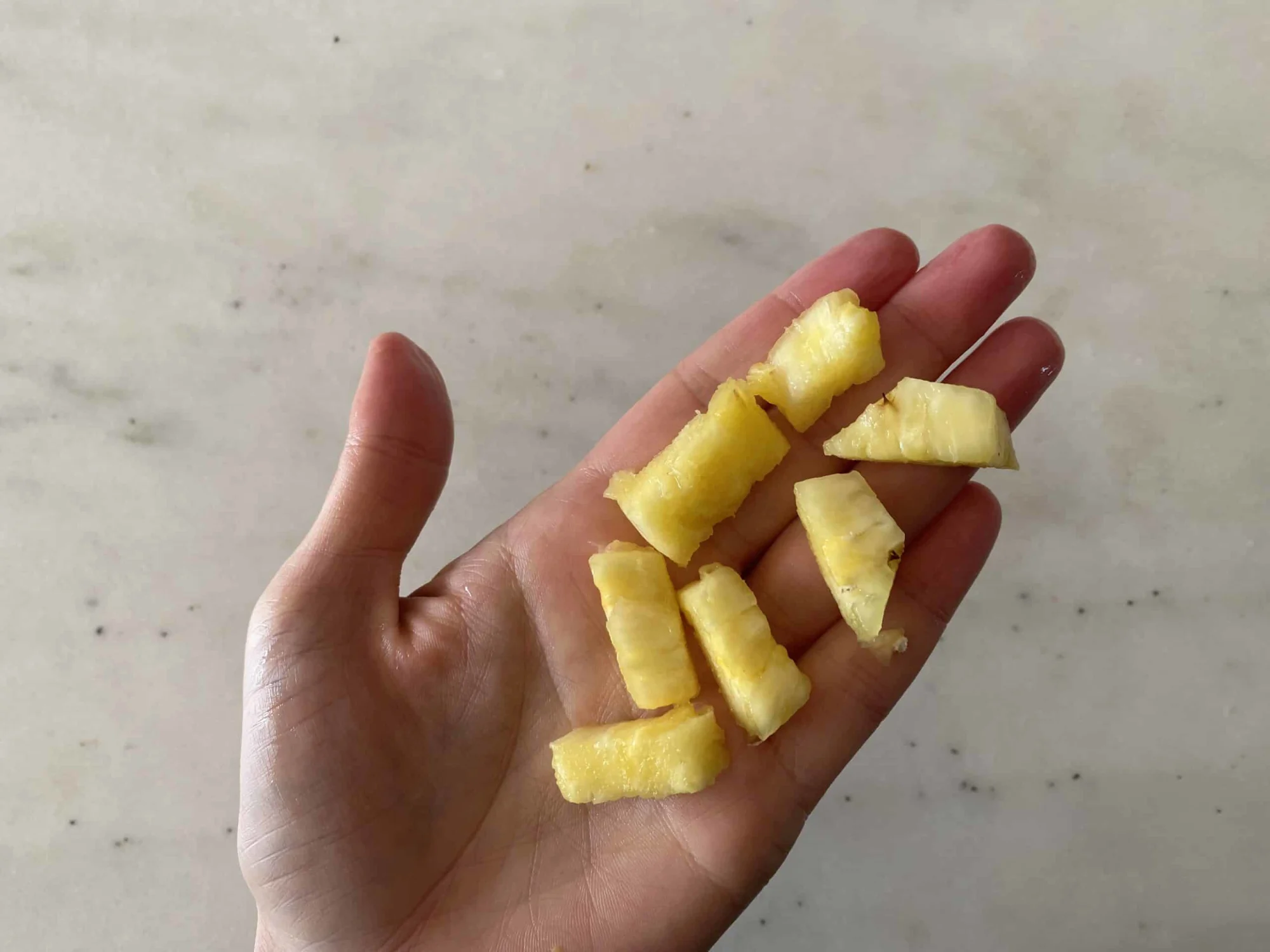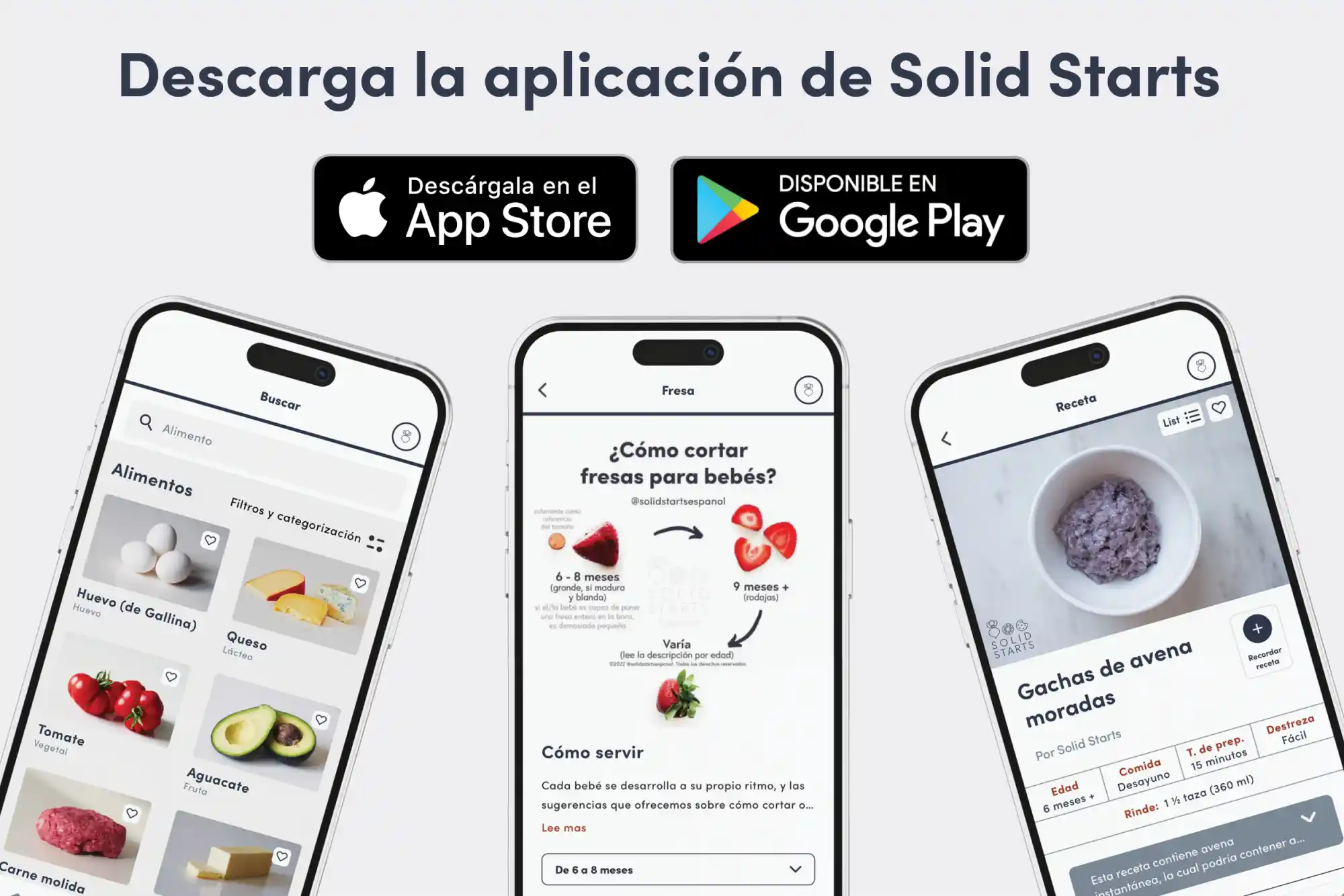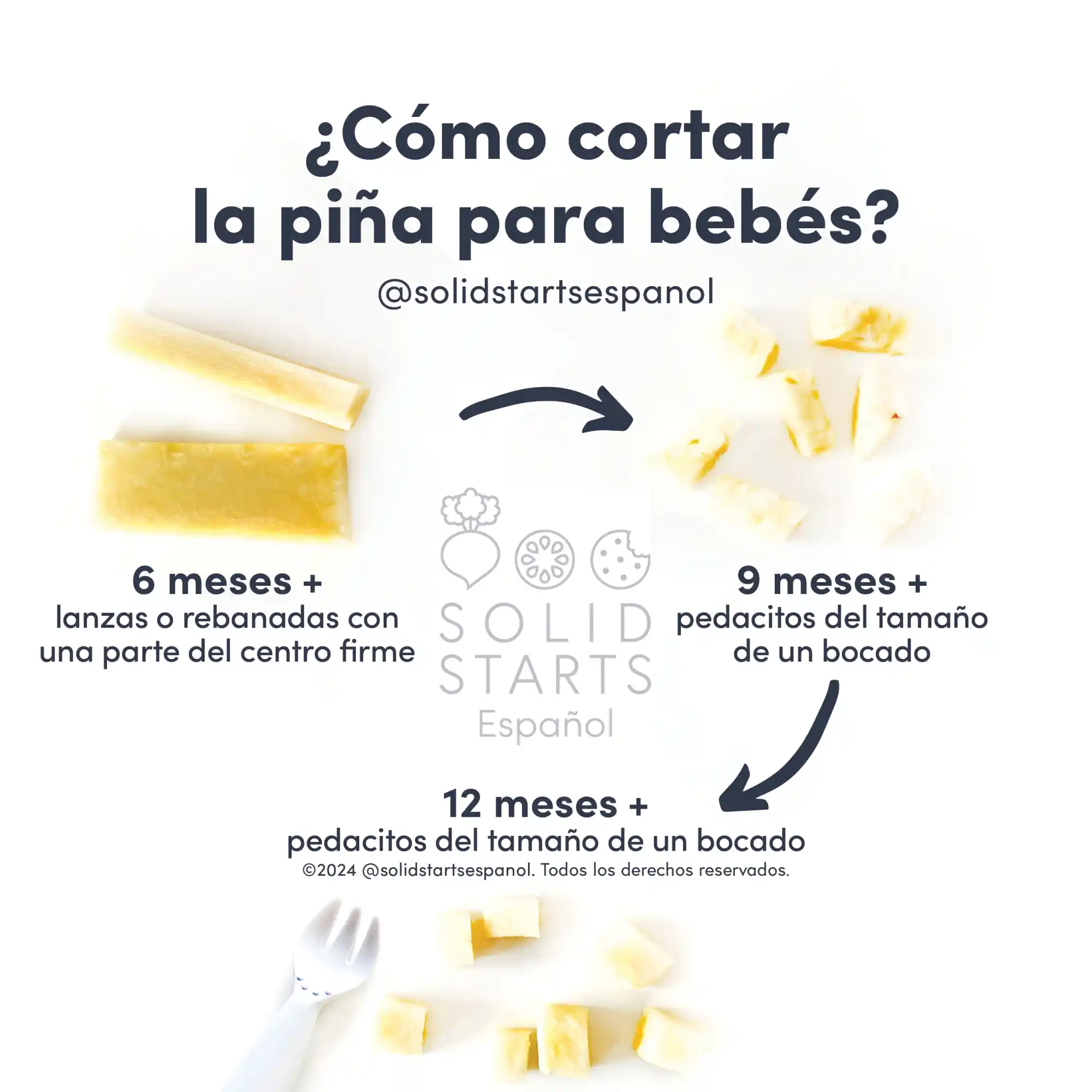Piña
Fruta
Sugerencia de edades
6 meses
Alto contenido de hierro
No
Alérgeno común
No

¿Cuándo pueden comer piña los bebés?
La piña puede comenzar a ofrecer tan pronto como el/la bebé esté listo/a para comer sólidos, lo cual es generalmente alrededor de los 6 meses de edad. La piña y otros alimentos ácidos, puede causar una irritación inofensiva y temporaria en la piel que entra en contacto con sus jugos y puede contribuir a rozaduras en el área del pañal.
La piña se ha cultivado por miles de años en su tierra de origen, las llanuras tropicales de Sudamérica, incluyendo el área que hoy es conocida como Brasil. En ese lugar, el pueblo Tupi, creó diversas maneras de convertir la fruta que ellos llaman na´na (entre otros nombres) en platillos nutritivos y bebidas fermentadas. La colonización de Brasil y otras partes del trópico americano introdujo la piña a Europa y al mundo, pero esta fruta se mantuvo como un alimento de lujo en muchos lugares de climas templados.
¿Es la piña saludable para los bebés?
Sí. La piña es una buena fuente de carbohidratos, vitaminas B6 y C, folato y fibra, así como pequeñas cantidades de otras vitaminas y minerales. En conjunto, estos nutrientes ayudan a dar soporte a la energía del/a bebé, a su metabolismo, a la absorción de hierro, al neurodesarrollo, a la salud digestiva y a la función inmune. La piña también contiene antioxidantes y carotenoides como la epicatequina. Cuando sirvas piña, asegúrate de que esté madura ya que la piña no madura puede ser irritante para el sistema digestivo.
La piña contiene bromelina, una enzima que ayuda a digerir la proteína y que puede causar irritación en la boca después de comer mucha de esta fruta. Debes saber que, aunque puede ser molesto, no hay de que preocuparse. Cocinar la piña puede ayudar a prevenir esta sensación y servir la fruta con alimentos neutralizantes como la leche de coco o yogur pueden ayudar a reducir esta sensación.
¿Es la piña un alérgeno común?
No. Las alergias a la piña son poco comunes, pero se han reportado y pueden ser más comunes en individuos con alergia al látex. Mientras que la mayor parte de las alergias a la piña no son severas, las alergias severas a la bromelina, la proteína mayormente alergénica en la piña, también se han reportado. Individuos con síndrome de alergia oral al polen o al látex pueden ser sensibles a la piña. El síndrome de alergia oral, usualmente causa una sensación corta de comezón, hormigueo o ardor y es poco probable que resulte en una reacción peligrosa. Consumir piña cocida o enlatada puede ayudar a minimizar la reacción. También se ha reportado que tratar la piña con sal o consumirla junto con productos lácteos puede ayudar a minimizar la reacción.
Las enzimas en la piña como la bromelina pueden irritar temporalmente la boca y lengua, causando una sensación de hormigueo o quemazón que puede ser difícil de distinguir del síndrome de alergia oral. Cocinar la piña puede ayudar a reducir la irritación.
Algunas veces, la acidez natural de la piña puede causar una irritación por contacto en la piel, típicamente alrededor de la boca, pero también ocasionalmente en el área del pañal. Esta irritación normalmente se elimina rápidamente sin necesidad de tratamiento. Para prevenir la reacción, puedes aplicar una pomada de barrera como vaselina o una combinación de aceite y cera vegetal a la cara y/o área del pañal antes de comer piña.
Si sospechas que el/a bebé puede ser alérgico a la piña, consulta un/a alergólogo/a. Como lo harías al introducir cualquier alimento nuevo, comienza ofreciendo una pequeña cantidad en las primeras porciones. Si no hay reacción adversa, aumenta gradualmente la cantidad durante las próximas comidas.
¿Es la piña un peligro de ahogamiento para los bebés?
Sí. La piña puede ser firme y resbalosa, dos cualidades que pueden incrementar el riesgo de ahogamiento. Para reducir el riesgo, prepara y sirve la piña de forma apropiada de acuerdo a la edad. Toma nota de que la piña tiene una consistencia mixta, en otras palabras, sólidos y líquidos juntos en un bocado de piña. Ambos componentes se mueven de manera diferente en la boca del/a bebé y la consistencia puede causar tos en la medida que el/a bebé practica comer este alimento. Como siempre, asegúrate de crear un ambiente de alimentación seguro y de mantenerte cerca del/a bebé durante las comidas.
Conoce los signos del ahogamiento y familiarízate con el protocolo de primeros auxilios en caso de ahogamiento con nuestras guías gratuitas de rescate para bebés y niños pequeños.
Videos
¿Cuando pueden tomar jugo de piña los bebés?
Puedes compartir probaditas de jugo como bebida a partir de los 12 meses de edad. Sin embargo, ten en en cuenta que puede ser beneficioso esperar hasta después de los dos años de edad para ofrecer jugos y otras bebidas azucaradas con regularidad. Las investigaciones sugieren que el consumo regular de jugos y otras bebidas dulces tiende a aumentar el riesgo de caries dentales y llenarles el estómago, lo que puede disminuir la motivación del/a niño para comer otros alimentos a la hora de comer y puede afectar negativamente su crecimiento. Sin embargo, una pequeña porción de jugo ocasionalmente después del año de edad generalmente no es un motivo de preocupación. Aprende más sobre el jugo y los bebés y niños pequeños.
¿Cómo ofrecer piña a los bebés?
Cada bebé se desarrolla a su propio ritmo, y las sugerencias que ofrecemos sobre cómo cortar o preparar determinados alimentos son generalizaciones para una amplia audiencia.
6 meses +:
Ofrece el centro de una piña madura como mordedor o tiras largas y planas de piña suave y madura. A pesar de que el centro no resultará en alimento, puede ayudar a avanzar las habilidades motoras ya que estimula reflejos que el/a bebe usa para aprender a masticar. Si el/a bebé puede morder el centro, deja de ofrecerlo para reducir el peligro de ahogamiento y ofrece piña madura y suave, pelada y cortada en tiras largas y planas del tamaño aproximado de dos dedos de adultos juntos. Cuando ofrezcas tiras, es importante asegurarse que la fruta esté suficientemente madura: sostén una tira entre tu dedo índice y pulgar y presiona gentilmente. Si puedes aplastar la fruta al presionar ligeramente con tus dedos, puedes ofrecerla al/a bebé a esta edad. Servir piña junto con alimentos cremosos como leche de coco o yogur puede ayudar a neutralizar la acidez natural de la piña y eliminar cualquier sensación de quemazón en la lengua.
A esta edad, no ofrezcas cubos pre cortados o pedazos de piña enlatada ya que estas formas representan un peligro de ahogamiento. Puedes picar finamente los cubos o pedazos grandes para minimizar el riesgo. De manera alternativa, ofrece rebanadas enteras de piña enlatada. Algunas piñas enlatadas pueden ser tan suaves que se deshacen en la mano del/a bebé; si el/a bebé está interesado en recoger y comer esos pedazos, está bien.
9 meses +:
Sirve pedazos del tamaño de un bocado de piña suave y madura, ya sea por sí sola como práctica de su pinza fina en desarrollo o como parte de un platillo. Asegúrate de que pase la siguiente prueba: sostén la piña entre tu dedo índice y pulgar y presiona gentilmente. Si puedes aplastar la fruta al presionar ligeramente, está bien ofrecerla al/a bebé a esta edad. Si quieres seguir ofreciendo el centro de la piña o tiras grandes y planas, lo puedes seguir haciendo. Solo deja de ofrecer el centro si el/a bebé lo puede morder completamente.
12 meses +:
Continúa ofreciendo pedazos de piña del tamaño de un bocado y considera servir la fruta con utensilios para que el/a bebé pueda practicar. Recuerda que el uso de utensilios puede ser agotador para nuevos comedores y que puede ser que el/a niño/a tome turnos entre los utensilios y sus dedos. El uso consistente y preciso de utensilios se dará con el tiempo, la mayoría de los niños puede usar el tenedor con precisión a los 3 años de edad.


Cómo preparar piña para bebés de 6 meses +
Sal de la rutina de servir los mismos almuerzos con nuestra guía 75 almuerzos para bebés y niños pequeños.
Nuestro equipo
Escrito por
Consejos de expertos directo a tu bandeja de entrada
¡Suscríbete y recibe correos semanales con recetas, consejos y más!
Copyright © 2024 • Solid Starts Inc






